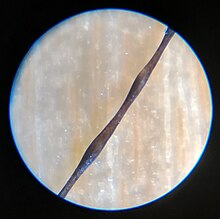| Monilethrix | |
|---|---|
| Other names | Moniliform hair syndrome |
 | |
| Beaded hair (60x magnification). | |
| Specialty | Medical genetics |
Monilethrix (also referred to as beaded hair)[1] is a rare autosomal dominant hair disease that results in short, fragile, broken hair that appears beaded.[2][3] It comes from the Latin word for necklace (monile) and the Greek word for hair (thrix).[4] Hair becomes brittle, and breaks off at the thinner parts between the beads. It appears as a thinning or baldness of hair and was first described in 1897 by Walter Smith[5]
- ^ James W, Berger T, Elston D (2005). Andrews' Diseases of the Skin: Clinical Dermatology (10th ed.). Saunders. ISBN 978-0-7216-2921-6.
- ^ Celep, F.; Uzumcu, A.; Sonmez, F.; Uyguner, O.; Balci, Y.; Bahadir, S.; Karaguzel, A. (2009). "Pitfalls of mapping a large Turkish consanguineous family with vertical monilethrix inheritance". Genetic Counseling (Geneva, Switzerland). 20 (1): 1–8. PMID 19400537.
- ^ Freedberg; et al. (2003). Fitzpatrick's Dermatology in General Medicine (6th ed.). McGraw-Hill. p. 639. ISBN 978-0-07-138076-8.
- ^ Genetic and Rare Diseases Information Center (2008-09-09). "Monilethrix". NIH Office of Rare Diseases Research. Archived from the original on 2012-07-30. Retrieved 2011-01-15.
- ^ Chabchoub, I.; Souissi, A. (2022). "Monilethrix". Monilethrix NCBI. StatPearls. PMID 30969635.